
Sushi bar, as you can already guess from the name, only serve sushi and sashimi, therefore, if you don’t really like raw fish, it is advisable to avoid them because you will have no alternatives as, instead, happens in classic Japanese restaurants. Even the way to consume the meal is different. In sushi bars you sit in front of a counter on which a conveyor belt runs. On the conveyor belt there are saucers containing different types of sushi, characterized by different colors. The color of the plate indicates the price of the sushi it contains. Compared to traditional restaurants, sushi bars are cheaper because based on the color of the chosen dishes, you can decide the final amount of the bill right away.
Difference between sushi bars and Japanese restaurants
Sometimes it can happen to get confused when it comes to ethnic restaurants and foreign cuisines. This also and especially applies when it comes to Japanese cuisine and Japanese catering in general. In Japan, there are many different types of restaurants, each characterized by a particular type of preparation. In the West, the best known types are mainly two: sushi bars and classic Japanese restaurants. We often tend to equate them, in reality they are two very different types of premises.
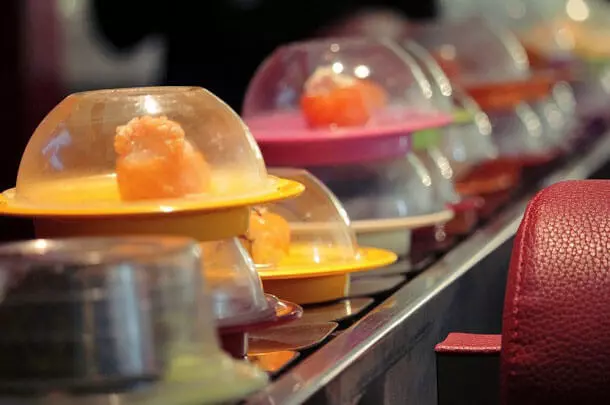
The main difference between sushi bars and Japanese restaurants is that, in the latter, you sit at a table, order your meal and are served by the waiters. A further difference is that in Japanese restaurants typical dishes of the food and wine culture of the Rising Sun are served and not just sushi as is the case in sushi bars. In fact, in the restaurants you can also eat the famous rice noodles, soups, udon, yakitori, etc. The last difference lies in the final bill, actually in sushi restaurants the cost is much higher than in sushi bars, even if it depends a lot on the type of dishes you order.
Kaiten-zushi sushi bar
In kaiten-zushi sushi bars, there is a continuously spinning conveyor belt between the dining room and the kitchen, where the chefs continuously prepare the sushi plates and place them on the conveyor belt, so customers sitting at the table or counter take from directly tape the dishes they are interested in. In many kaiten-zushi, the cost of the dishes is the same for all sushi plates, while outside Japan, the price is determined by the color of the plate itself.

Sushi bar menu
The litmus test for the Japanese, when they find themselves having to eat for the first time in a sushi bar they don’t know or where they’ve never eaten before, is to order a nigiri-tamago, or a piece of nigiri with an omelette on top. This type of nigiri is very cheap and can be used to understand if the rice has been prepared with care or if it is appropriate to say goodbye and go to another sushi bar.
In some types of sushi bars there is the classic menu from which to order the dishes that are prepared by the chef on duty. The nigiri sushi is served in pairs, while the maki in portions of four, six or eight pieces. Usually it is customary to order one portion at a time or a set-menu, i.e. a complete menu chosen from the various menus available at that moment. If you are undecided about what to order, you can tell the chef the word amakase, which means leave it to her. In this case he will take care of everything without bothering to choose. But what are the tastiest and most typical recipes of Japanese cuisine that you need to order if you go to a sushi bar?

Variety of dishes on the menu
In a Japanese sushi bar you can taste a wide variety of Japanese appetizers, such as edaname, wakame suomono, Maguro Tataki, or the prestigious sake tartare, made up of marinated salmon and sake with teriyaki sauce.
The gastronomic offer continues with other delicacies such as temaki, which are cones of nori seaweed inside which there is rice and different varieties of fish, raw or cooked. Temaki sake, for example, contains salmon and avocado, California temaki, on the other hand, contains tuna and avocado sauce, while negitoro temaki contains tuna, spring onions and hot sauce. Hosomaki also seem to be very popular in sushi bars. These are dishes made up of small rice rolls wrapped in nori seaweed. Different types of fish can be added to these rolls: salmon, tuna or eel.
Entrees are also available, such as grilled seafood rice, grilled rice with chicken in teriyaki sauce, or grilled seafood spaghetti. Even cooking on the plate, therefore, is a cooking method widely used in Japanese cuisine.
To round off the meal, excellent Japanese desserts, such as rice pudding and green tea flavored ice cream (both very popular).
How to choose the local sushi bar
The main rule is to be wary of Chinese establishments converted into Japanese establishments. Generally, these are former Chinese restaurants that have been hastily converted to enter the sushi market. The advice is to choose an authentic sushi bar, with a Japanese chef: according to their culture, the Japanese are very scrupulous and precise in the choice of raw materials, in compliance with hygiene standards and in compliance with the rules in general.
If you don’t want to risk choosing a sushi bar, you can prepare sushi at home with the certainty of the quality of the ingredients and hygiene during preparation. Just order the TEXOLIQ bazooka sushi kit to prepare good DIY sushi.
Risky dishes in sushi bars
Maki, hosomaki, uramaki, temaki, gunkan, sashimi and in general all raw fish dishes are at risk of infection: for example, they may contain anisakis larvae, a worm that causes serious health problems. The legislation requires that the rooms in which it is served be equipped with blast chillers which kill the parasite in a very short time without affecting the fragrance of the meat. However, from many surveys conducted it has been discovered that only a few sushi bars in the West adopt rapid freezing. If you are not sure of the quality of your trusted sushi bar, you don’t necessarily have to give up good sushi, just order the TEXOLIQ sushi kit and preparing it becomes child’s play.
Guarantees on the quality of fish in sushi bars
In a sushi bar it is not easy to understand if the fish served is really fresh because you are dealing with ready-made fillets, perhaps well hidden inside a roll of rice. Here are some tricks to keep an eye on to see if the fillet is of good quality.
In general, fresh fish fillets are firm, tasty and never dry. The color must not turn towards gray tones, it must be bright and natural (a tuna that is too blue, for example, could have been treated with carbon monoxide, which is antibacterial). The smell must be delicate, of the sea, never strong or unpleasant. As regards the origin of the fish, however, controls are tight. All foods arriving in Europe, including ethnic ones, are supervised and comply with precise health and hygiene standards. To be clear: you don’t run the risk of eating tuna that comes from Fukushima. If you want greater safety and a guarantee on the quality of the fish, you should buy it personally following the advice described above and prepare good sushi at home with the TEXOLIQ preparation kit.
Etiquette in sushi bars
Below is the list of do’s and don’ts at a Japanese sushi bar.
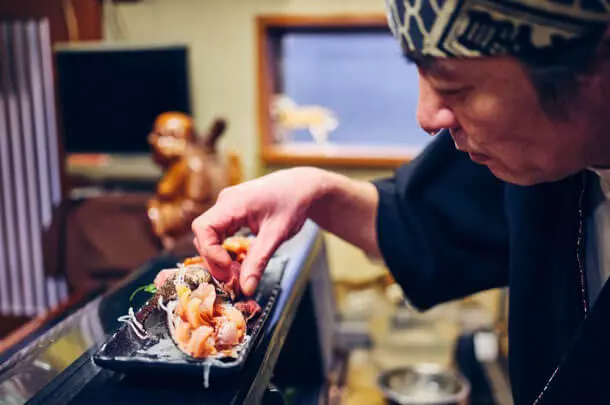
Beware of ginger
Eat the pickled ginger slice with chopsticks as a taster and not as a salad. The taste is quite strong, and the slices are only meant to be taken in small doses between dishes.

Finish the dish
Eat whatever is served, as it is considered bad taste in Japan to refuse food.
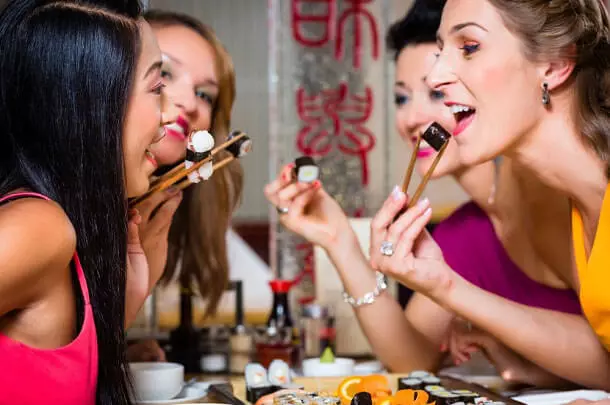
Unique bites
In Japan, sushi is served in small pieces so that it can be eaten in one bite. It is generally considered good practice to eat sushi in one bite.

Respect the sushi chef
In a traditional sushi bar you have to order the food only and exclusively from the chef (ie sushi and sashimi), for any other request you have to ask the waiter. Above all, never ask the chef if the fish is fresh. In a Japanese sushi bar the fish is always fresh.

Beware of wasabi
Use wasabi very sparingly.

Wash your hands well
Clean your hands before ordering in a sushi bar. When the waiter brings a hot towel before your meal, remember it’s for cleaning your hands. If using chopsticks is difficult, using your hands is perfectly acceptable.

Integrate into Japanese culture
It would be polite to learn a few sentences in the native language. “Arigato gozaimasu” means “thank you”, and “sumimasen” can be used as an “excuse”, when you want to call the waiter or the chef. Traditionally, the waiter will say Itadakimasu! at the beginning of a meal, and Gochisousama deshita! at the end of the meal. Even if not all sushi bars are run by Japanese people, it’s a good thing not to find yourself unprepared and learn just a few Japanese words.
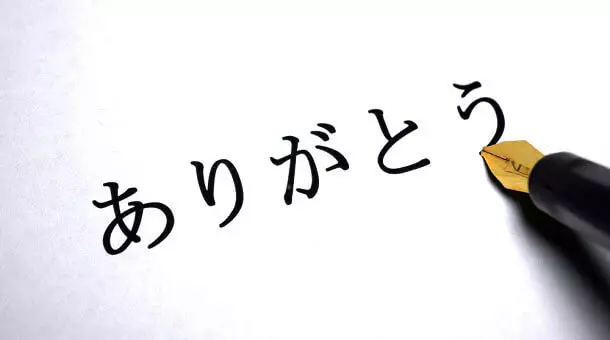
Respect the elders
In Japan it is customary for the youngest to pour tea for the elder or elders present. If you are in a sushi bar with an older person, it would be a good idea to pour tea into their cup.
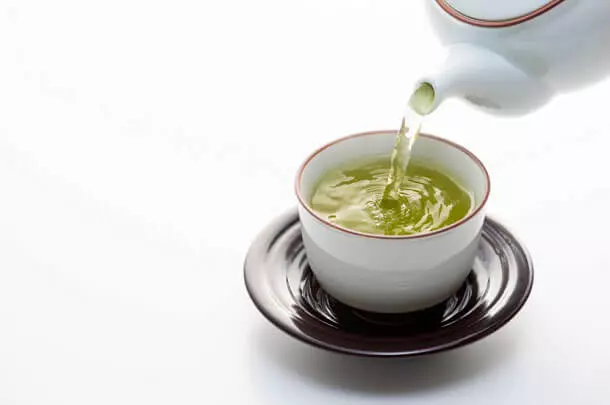
Knife? No thank you
Never ask the waiter or the chef for a knife. Sushi doesn’t need sharp tools, chopsticks and/or hands are enough to enjoy it.
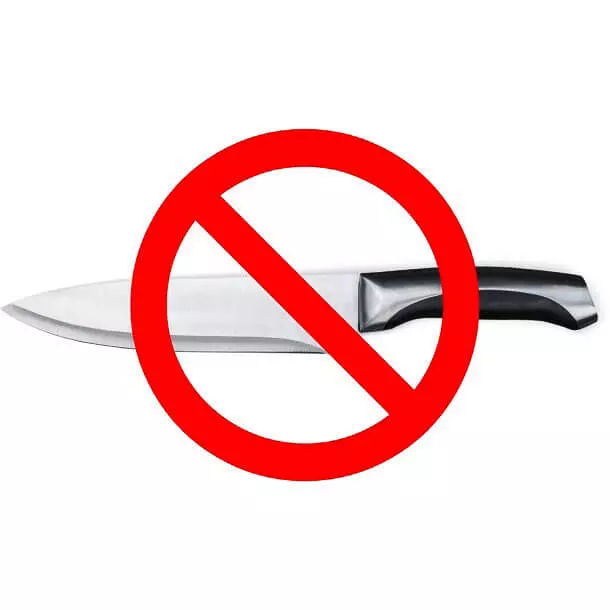
I recommend sushi chef
Get advice directly from the chef regarding the conditions of the fish, as being fresh fish it varies according to the season and the period in which it was caught.

Smoking prohibited
Never smoke in a sushi bar, even outdoors. Heavy smells, such as smoke or the scent of aftershave will drown out any subtle tastes in the fish and disturb other people sitting in the sushi bar.

